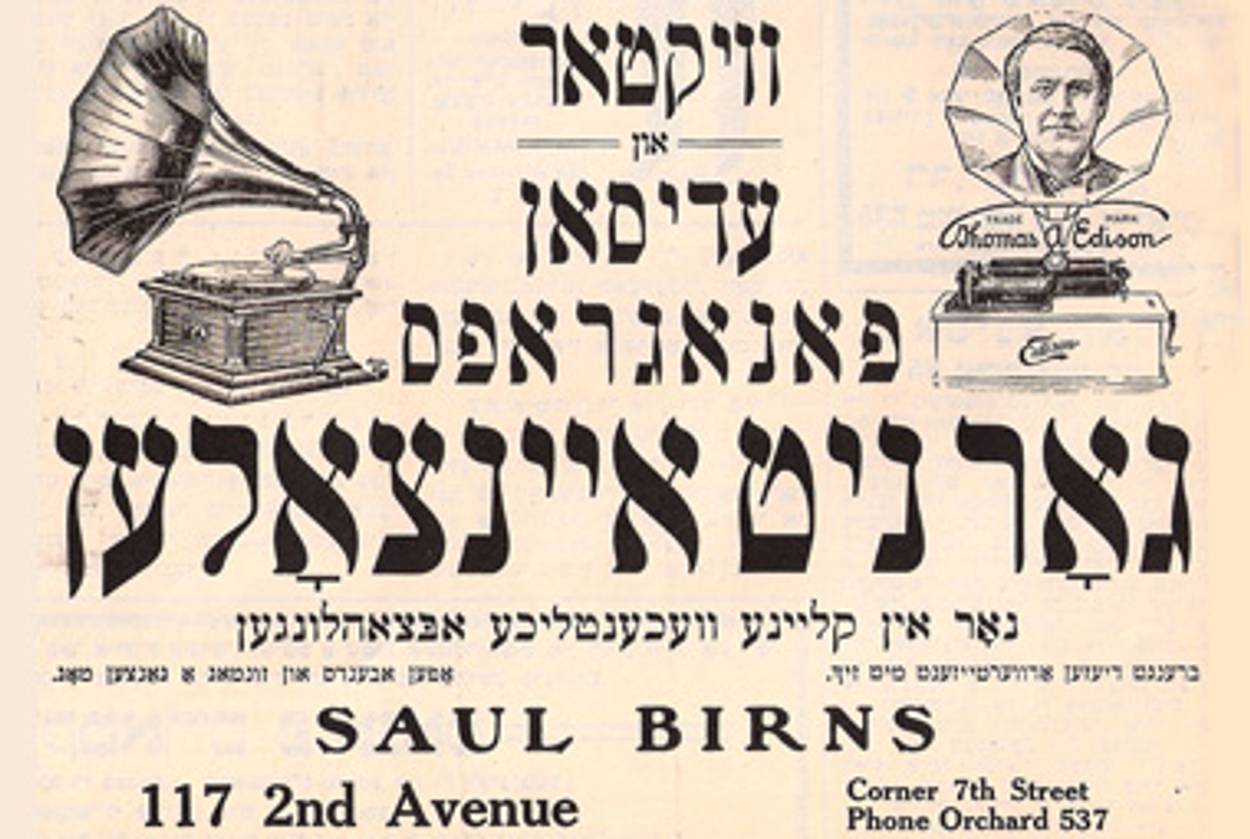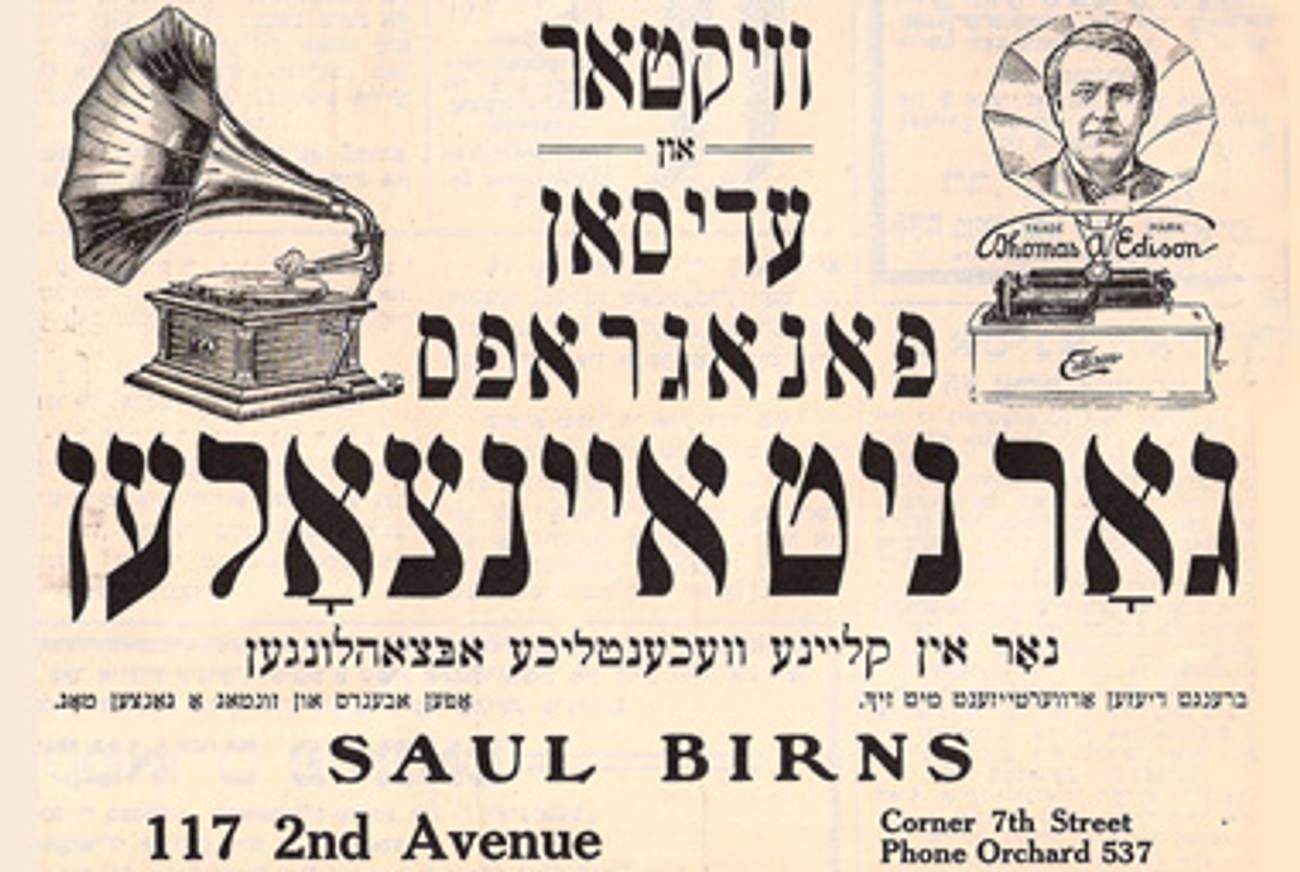Treasure Trove
A new box set offers a taste of one of the world’s great Jewish music collections




For as long as I can remember, my father has made fun of Hasidim. In fact, he rarely uses that word; instead, he refers to the Hasidic Jews in my hometown of Montreal, who happen to be prominent in the textile and garbage-bag industries, as “garmentologists” or “garbologists.”
As a child, I thought this was a personal tic. Then, thanks to Chaim Potok, Robby Benson, and The Chosen, I learned that non-Hasidic Jews have long looked askance at their bearded, furry-hatted brethren. Still, I was surprised to find an example of musical Hasid-baiting dating back to 1929 on Cantors, Klezmorim and Crooners 1905-1953: Classic Yiddish 78s from the Mayrent Collection, a new 3-CD box set on the JSP label.
That track, “Yidden, Loift Tzum Rebbin” (“Jews, Run to the Rabbi”), is one of 69 culled from the more than 17,000 sides owned by Sherry Mayrent, a klezmer clarinetist and associate director of Living Traditions, the organization behind KlezKamp and various other projects devoted to the dissemination of Yiddish culture. One of the vast number of “ethnic recordings” made for and marketed to everyone from blacks to hillbillies during the prewar period, it skewers the stereotypically sheep-like deference that Hasidic Jews show towards their miraculously endowed rebbes (“Bring it Jews, Hasidim/Hand the rebbe all your money/Come on women, don’t ask questions/He will brighten up your world”). The humor of “Chasidic in America,” recorded in 1938, is more subtle, as Moishe Oysher and Florence Weiss punctuate their jazz-inflected vocals with “oy veys” and “chiri biri bim boms.” It’s a wonder that the box set includes either, however, given that most reissues of archival Jewish material tend to focus on klezmer music, or cantorial singing, or some other institutionally recognized, “serious” cultural artifact.
Which is not to say that Cantors, Klezmorim and Crooners—or the larger collection from which it is drawn (currently the largest accumulation of Jewish 78s in private hands)—doesn’t contain plenty of that, too. The CDs feature but a tiny fraction of what’s buried in the 9,000-odd discs that Mayrent has acquired on eBay (she picked up the first 100 for a mere $40) and from dealers around the world, and which Living Traditions is now cataloging, digitizing, and documenting. But it’s enough to give you some sense of the tremendous diversity of Jewish cultural expression during the 78 era, which stretched from the late 19th century—a full 25 years before the advent of radio—to the early 1950s, a span that saw the efflorescence of Yiddish theater, the rise of “hebe” dialect humor, and the eager engagement of a rapidly assimilating immigrant community with American culture at large.
Alongside the expected tracks by klezmer legends like clarinetist Naftule Brandwein and Kandel’s Orchestra and Jewish pop stars such as Sophie Tucker and the Barry Sisters, we find gems like a 1915 pressing of Sholom Aleichem reading from “If I Were Rothschild”; the first recording of Kol Nidre from 1924; and a cut from 1912 featuring Joe Hayman doing his “Cohen on the Telephone” routine, a surprisingly gentle bit of dialect humor in which a Yiddish speaker with a heavy accent has his first English phone conversation. The cantorial performances trace a clear arc from traditional Orthodox practice through modern Reform stylings, but they also include a couple of sui generis outliers like a recording of “Mi Sheoso Nisim” by Cantor Berele Chagy from 1919, which had me marveling, open-mouthed, at his melismatic ululations and eerie falsetto.
According to Henry Sapoznik, the executive director of Living Traditions and the man who got Mayrent hooked on 78s, the very scope of the larger collection distinguishes it from other archival holdings of Jewish material, as does the care with which the recordings have been transferred to digital form—a process that has resulted in some stunningly clear reproductions, like the 1913 side by Belf’s Roumanian Orchestra, a European klezmer outfit that enjoys iconic status among contemporary scholars of Jewish music but which has rarely, if ever, sounded so good to contemporary ears. A serious collector of Jewish material himself—he produced the first reissue of klezmer 78s in 1982, and his collection of Yiddish radio programs was recently acquired by the American Folklife Center at the Library of Congress—Sapoznik explains that Cantors, Klezmorim and Crooners is not an end unto itself. Rather, it’s meant to draw attention to the parent collection, which Mayrent hopes to make available online in its entirety, and to KlezKamp, which helped pioneer the use of archival recordings as a learning tool for aspiring performers of Jewish music.
Whether Mayrent and Living Traditions are ultimately able to make the whole thing free and open to the public online remains to be seen. Mayrent is currently negotiating with the University of Wisconsin at Madison to establish an institute of Yiddish culture that would serve as a permanent home for her discs, maintaining a searchable online database through which music-seekers could download every single recording. But the deal has yet to be sealed, and there remain tricky issues of copyright: the 78s were originally released by commercial labels such as Columbia and Victor whose catalogs have since been acquired by companies like Sony and Bertelsmann—companies that have become increasingly paranoid about online access to their property.
Still, Sapoznik is optimistic. Living Traditions has already transferred over 3,000 discs, and the first batch could go online within a year or two. In the meantime, we must content ourselves with the box set. It might fall far short of the wonder that is the full collection, but when it comes to legacy material that reveals the popular tastes of the Jewish community at a time of great cultural ferment, it is far better than anything else out there.
Alexander Gelfand is a recovering ethnomusicologist, a sometime jazz pianist, and a former West African drummer. His work has appeared in the New York Times, the Chicago Tribune, the Forward, and elsewhere.
Alexander Gelfand is a recovering ethnomusicologist, a sometime jazz pianist, and a former West African drummer. His work has appeared in the New York Times, the Chicago Tribune, the Forward, and elsewhere.